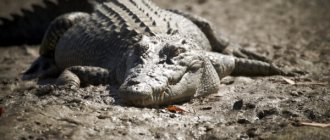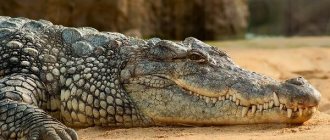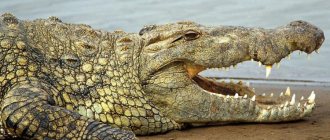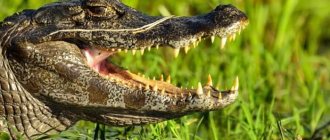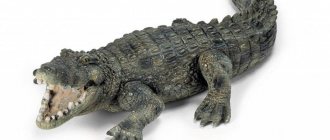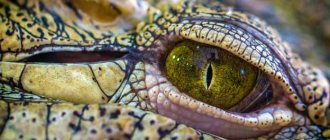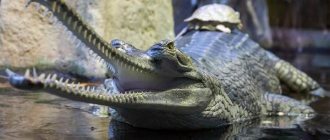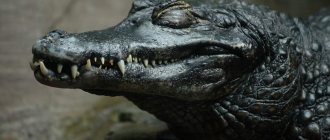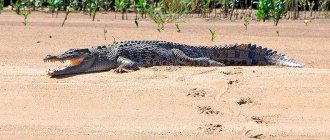- Wild animals
- >>
- Reptiles
The Nile crocodile is one of the most dangerous reptiles. He is responsible for countless human casualties. This reptile has been terrifying the living creatures around it for many centuries. This is not surprising, because this species is the largest among the other two living in Africa. In size it is second only to the saltwater crocodile.
Origin of the species and description
Photo: Nile crocodile
This subspecies is the most common representative of its genus. Mention of these animals dates back to the history of Ancient Egypt, but there are theories that crocodiles inhabited the Earth back in the days of dinosaurs. The name should not be misleading, because it inhabits not only the Nile River, but also other bodies of water in Africa and neighboring countries.
Video: Nile crocodile
The species Crocodylus niloticus belongs to the genus of True crocodiles of the Crocodilidae family. There are several unofficial subspecies, whose DNA tests have shown some differences, due to which populations may have genetic divergences. They do not have a generally recognized status and can only be judged by differences in size, which may be due to habitat:
- South African;
- West African;
- East African;
- Ethiopian;
- Central African;
- Malagasy;
- Kenyan.
More people have died from the teeth of this subspecies than from all other reptiles. Nile cannibals kill several hundred people every year. However, this does not prevent the natives of Madagascar from considering the reptile sacred, worshiping it and organizing religious holidays in their honor, sacrificing domestic animals.
Appearance and features
Photo: Nile crocodile reptiles
The body length of individuals together with the tail reaches 5-6 meters. But sizes may vary due to habitat. With a length of 4-5 meters, the weight of reptiles reaches 700-800 kilograms. If the body is longer than 6 meters, then the mass can fluctuate within a ton.
The structure of the body is built in such a way that hunting in water is as effective as possible for crocodiles. A powerful and large tail helps to move quickly and push off from the bottom in such a way as to make jumps over distances much greater than the length of the body of the crocodile itself.
The reptile's body is flattened, its short hind legs have wide membranes, and its back has scaly armor. The head is elongated, in the upper part there are green eyes, nostrils and ears, which can remain on the surface while the rest of the body is submerged under water. There is a third eyelid on the eyes to clean them.
The skin of young individuals is greenish, with black spots on the sides and back, and yellowish on the belly and neck. With age, the color becomes darker - from green to mustard. There are also receptors on the skin that detect the slightest water vibrations. The crocodile hears and recognizes smells much better than it sees.
Reptiles can stay under water for up to half an hour. This occurs due to the heart's ability to block blood flow to the lungs. Instead, it goes to the brain and other important life-support organs. Reptiles swim at a speed of 30-35 kilometers per hour, and move on land no faster than 14 kilometers per hour.
Thanks to a leathery growth in the throat that prevents water from entering the lungs, Nile crocodiles can open their mouths underwater. Their metabolism is so slow that reptiles may not eat for dozens of days. But when they are really hungry, they can eat up to half their own weight.
Gustav
A huge representative of the Nile crocodile living in Lake Tanganyika caused a lot of trouble, killing more than 300 people.
Residents of the state of Burundi, in whose territory the man-eating giant lives, consider him a deity, worship and make sacrifices to him.
He has been hunted with military weapons (even an AKM) for decades, but the bullets seem to bounce off his skin.
Gustav's approximate age is 60 years. Over the years it has reached enormous sizes - more than 6 meters in length. The weight and girth of the giant’s body is unknown for obvious reasons: living witnesses saw it only from afar.
Local residents and hunters recognize the killer crocodile by its numerous bullet scars. French explorer and hunter Patrice Fayet, who has been tracking since 1998, gave him the nickname “Gustav”, which stuck.
An experienced naturalist has not been able to track the sinister cannibal for more than 20 years, because, as if guessing about the next action or expedition to capture it, the reptile moves across the lake to neighboring Tanzania or Congo.
From time to time, when Gustav disappears from view for a long time, reports come about his death from old age, or murder, but they turn out to be false. When harvesting the next Nile giant, it turns out that the bullet scars are missing or located differently.
Several attempts were made to catch Gustav in a 10 m long, 1.5 m high, 2 m wide trap baited with a live goat. But the cast-iron cage turned out to be upside down, drowned, without a goat, or other crocodiles got into it.
Numerous observations of the monstrous cannibal indicate that he repeatedly dealt with even adult hippos - the eternal enemies of the Nile reptiles.
Over the decades of hunting the ominous predator, he showed signs of cunning, even managed to deceive, subtly mock the hunters, leaving the bodies of killed people on the shore.
The bulletproof “Devil” of the Republic of Burundi continues to exist, threatening the local population with new victims.
Where does the Nile crocodile live?
Photo: Nile crocodile in water
Crocodylus niloticus live in the waters of Africa, on the island of Madagascar, where they have adapted to life in caves, on the Comoros and Seychelles islands. The habitat extends south of the Sahara, in Mauritius, Principe, Morocco, Cape Verde, Socotra Island, Zanzibar.
The fossil remains found make it possible to judge that in the old days this species was distributed in more northern territories: in Lebanon, Palestine, Syria, Algeria, Libya, Jordan, the Comoros Islands and not so long ago completely disappeared from the borders of Israel. In Palestine, a small number lives in a single place - the Crocodile River.
The habitat is reduced to freshwater or slightly salty rivers, lakes, reservoirs, swamps, and can be found in mangrove forests. Reptiles prefer calm bodies of water with sandy shores. You can meet an individual far from water only if the reptile is looking for a new habitat due to the drying out of the previous one.
In isolated cases, Nile crocodiles were found several kilometers from the coast in the open sea. Although such actions are not typical for this species, movements in salt water have allowed the reptiles to spread and reproduce to small populations on some islands.
Habitat
The name “Nile crocodile” does not mean limiting the habitat of this animal only to the greatest African river. The reptile's range extends south of the Sahara Desert to Central and South Africa, and part of Madagascar.
The Nile crocodile inhabits the banks of rivers, lakes, and swamps. In water, reptiles are very active.
On land they move slowly, but can reach high speeds, going into a gallop. At times, Nile reptiles hunt on land if they find a desired prey.
Crocodiles can stay under water, without oxygen, for up to 30 minutes, and in an inactive, cooled state for up to 2 hours.
What does the Nile crocodile eat?
Photo: Nile crocodile Red Book
These reptiles have a fairly varied diet. Young individuals mainly eat insects, crustaceans, frogs, and mollusks. Adult crocodiles need food much less often. Growing reptiles gradually switch to small fish and other inhabitants of water bodies - otters, mongooses, reed rats.
70% of the food of reptiles consists of fish, the remaining percentage is made up of animals that come to drink.
It can be:
- zebras;
- buffalos;
- giraffes;
- rhinoceroses;
- wildebeest;
- hares;
- birds;
- felines;
- monkey;
- other crocodiles.
They drive amphibians to the shore with powerful movements of their tail, creating vibrations, and then easily catch them in shallow water. Reptiles can line up against the current and freeze, waiting for spawning mullet and mullet to swim past. Adults prey on Nile perch, tilapia, catfish and even small sharks.
Reptiles can also take food from lions and leopards. The largest individuals attack buffalos, hippopotamuses, zebras, giraffes, elephants, brown hyenas, and baby rhinoceroses. Crocodiles eat food at every opportunity. Only the females, who protect their eggs, eat little.
They drag their prey underwater and wait for it to choke. When the victim stops showing signs of life, the reptiles tear it to pieces. If food was obtained jointly, they coordinate efforts to share it. Crocodiles can push their prey under stones or driftwood to make it easier to tear it apart.
Features of character and lifestyle
Photo: Great Nile crocodile
Most crocodiles spend the day in the sun to increase their body temperature. To avoid overheating, they keep their mouths open. There are known cases when poachers gagged the caught reptiles and left them in the sun. The animals died from this.
If a Nile crocodile suddenly closes its mouth, this serves as a signal to its relatives that danger is nearby. By nature, this species is very aggressive and does not tolerate strangers on its territory. At the same time, they can coexist peacefully with individuals of their own species, relax and hunt together.
In cloudy and rainy weather, they spend almost all their time in the water. In areas with variable weather conditions, drought or sudden cold snaps, crocodiles can dig niches in the sand and hibernate throughout the summer. To establish thermoregulation, the largest individuals go out to bask in the sun.
Thanks to their camouflage coloring, hypersensitive receptors and natural power, they are excellent hunters. A sharp and sudden attack does not give the victim time to come to his senses, and powerful jaws leave no chance of survival. They go out onto land for hunting no further than 50 m. There they wait for animals along forest paths.
Nile crocodiles have mutually beneficial relationships with some birds. Reptiles open their mouths wide while clawed lapwings or, for example, Egyptian runners pick out stuck pieces of food from their teeth. Female crocodiles and hippos coexist peacefully, leaving offspring on each other for protection from felines or hyenas.
general characteristics
The body, tail and legs of crocodiles are covered with hard skin, which is formed as an ossified plate.
The sizes of crocodiles, depending on the variety, range from 2-7 meters, although their weight can reach up to 1000 kg. In nature there are also larger crocodiles, whose weight can be more than 2 tons. At the moment, the entire family can be divided into true crocodiles, alligators and gharials. However, their anatomy is similar, which is manifested, among other things, by the presence of maximum adaptability to living in water. Thus, crocodiles have a flattened body, a flat head, on which there is a long snout and short legs. The front paws have five toes, and the hind paws have four toes, which are connected to each other by membranes. Crocodiles have nostrils located on the top of their heads, allowing crocodiles to dive into water and breathe while simultaneously observing what is happening in the area. They have developed night vision, and their ears and nostrils are covered with skin folds.
Despite the fact that crocodiles are cold-blooded, they successfully adapt to temperature conditions thanks to muscle tension.
The tail of crocodiles is large and performs a number of functions: for reptiles, the tail is at the same time an engine, a steering wheel and a temperature regulator.
Crocodiles are mostly black, dirty brown, olive or gray in color. This color helps create natural camouflage and remain invisible.
Sometimes albino crocodiles are found, but they are not able to live in natural habitats for a long time.
Crocodiles have a rather unusual respiratory system. They have large lungs that hold a large amount of air, which helps them hold their breath for a long time.
The diaphragm, consisting of connective tissue, can influence the movement of internal organs in the longitudinal direction, which changes the center of gravity to ensure a suitable position of the body in the aquatic environment. Also, the nasopharynx is separated from the oral cavity with the help of a secondary bony palate, which allows crocodiles to keep their mouths open under water and at the same time continue to breathe through the nostrils, which are located on top of the water surface.
Social structure and reproduction
Photo: Baby Nile crocodile
Reptiles reach sexual maturity at the age of ten years. By this time their length reaches 2-2.5 meters. During the mating season, males slap their muzzles into the water and roar loudly, attracting the attention of females. They, in turn, choose larger males.
In northern latitudes, the onset of this period occurs in summer; in the south it is November-December. Hierarchical relationships are built between males. Everyone tries to show their superiority over their opponent. Males growl, exhale noisily, and blow bubbles with their mouths. At this time, the females excitedly slap their tails on the water.
The defeated male quickly swims away from his competitor, admitting his defeat. If it is not possible to escape, the loser raises his face up, indicating that he is giving up. The winner sometimes grabs the loser's paw, but does not bite. Such battles help drive away extra individuals from the territory of an established pair.
Females lay eggs on sandy beaches and river banks. Not far from the water, the female digs a nest about 60 centimeters deep and lays 55-60 eggs there (the number can vary from 20 to 95 pieces). She does not allow anyone near the masonry for approximately 90 days.
During this period, the male can help her, scaring away strangers. At a time when the female is forced to leave the clutch due to the heat, the nests can be destroyed by mongooses, people or hyenas. Sometimes the eggs are carried away by floods. On average, 10-15% of eggs survive to the end of their term.
When the incubation period ends, the babies make grunting sounds, which serves as a signal for the mother to dig up the nest. Sometimes she helps the babies hatch by rolling the eggs in her mouth. She carries newborn crocodiles to a pond.
Natural enemies of Nile crocodiles
Photo: Nile crocodile
Adults have virtually no enemies in nature. Crocodiles can die prematurely only from larger representatives of their species, large animals like lions and leopards, or at the hands of humans. The eggs they lay or newborn babies are more susceptible to attacks. Nests can be stolen by:
- mongooses;
- birds of prey such as eagles, buzzards or vultures;
- monitor lizards;
- pelicans.
Unattended children are hunted by:
- felines;
- monitor lizards;
- baboons;
- wild boars;
- goliath herons;
- sharks;
- turtles.
In many countries where there are a sufficient number of individuals, hunting for Nile crocodiles is allowed. Poachers leave rotten animal carcasses on the shore as bait. A hut is set up not far from this place and the hunter waits motionless for the reptile to bite the bait.
Poachers have to lie still the entire time, because in places where hunting is allowed, crocodiles are especially careful. The hut is placed 80 meters from the bait. Reptiles can also pay attention to the unusual behavior of birds that see a person.
Reptiles show interest in bait throughout the entire day, unlike other predators. Poachers attempt to kill only crocodiles that have completely emerged from the water. The hit must be as accurate as possible, because if the animal manages to reach the water before it dies, it will be very difficult to pull it out.
Breeding in captivity
To solve the economic problems of obtaining valuable crocodile meat and industrial leather, reptile breeding farms have been organized in many countries of the world. Among them, the Nile crocodile is quite often represented.
Receiving enough food and care on the farm, the reptiles become tame. Some of them can be stroked and picked up by farm workers.
Predatory reptiles raised on farms do not show aggression towards their feeders, as they are not familiar with the feeling of hunger and competition for food.
Population and species status
Photo: Nile crocodile reptiles
In 1940-1960, there was an active hunt for Nile crocodiles because of the high quality of their skin, edible meat, and in Asian medicine, the internal organs of reptiles were considered endowed with healing properties. This led to a significant decrease in their numbers. The average lifespan of reptiles is 40 years, some individuals live up to 80.
Between 1950 and 1980, according to unofficial estimates, about 3 million Nile crocodiles skins were killed and sold. In some areas of Kenya, giant reptiles were caught with nets. However, the remaining number allowed the reptiles to be assigned the status of “Least Concern.”
Currently, there are 250-500 thousand individuals of this species in nature. In southern and eastern African countries, the number of individuals is monitored and documented. In western and central Africa, things are somewhat worse. Due to lack of attention, the population in these areas has been significantly reduced.
Poor living conditions and competition with narrow-snouted and blunt-snouted crocodile provoke the threat of extinction of the species. Reducing the area of swamps is also a negative factor for existence. To eliminate these problems, it is necessary to develop additional environmental programs.
